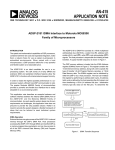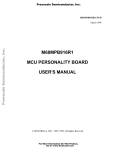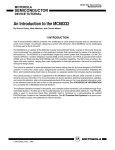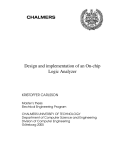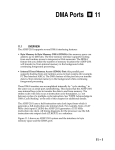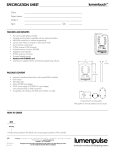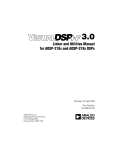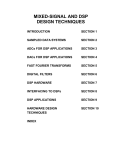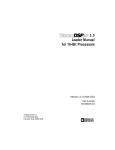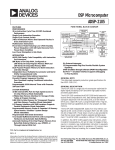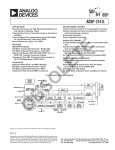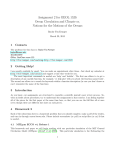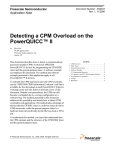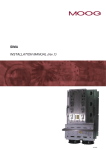Download a Engineer To Engineer Note EE-115
Transcript
a Engineer To Engineer Note EE-115 Technical Notes on using Analog Devices’ DSP components and development tools Phone: (800) ANALOG-D, FAX: (781) 461-3010, EMAIL: [email protected], FTP: ftp.analog.com, WEB: www.analog.com/dsp ADSP-2189 IDMA Interface to Motorola MC68300 Family of Microprocessors Note: This is the modified AN-415 Application Note for the ADSP-2189 and the new tools INTRODUCTION The speed and mathematical capabilities of DSP processors, combined with their low cost and expanded integration, make them a natural choice for use as signal co-processors in embedded environments. When paired with a host microprocessor, a DSP processor allows for a very powerful and flexible system at a reasonable price. The ADSP-2189 is an ideal candidate for use in a co-processing system. The 192K Bytes on chip RAM, configured as 32K words of on-chip Program Memory RAM and 48 K words on chip Data Memory RAM and extensive DMA and peripheral interface features allow the ADSP-2189 to function with minimal external support circuitry. In order to realize the highest possible performance in a co-processor system, efficient host-DSP communication is vital. The popular Motorola M68300 Family of microcontrollers provides a powerful and flexible bus interface that is easily adaptable to a coprocessing system. This application note describes an example hardware and software interface between the Internal DMA (IDMA) Port of the ADSP2189 and the Motorola M68300 Family of microcontrollers. As each specific system design has its own requirements and challenges, this application note does not presume to provide the only possible solution. Rather it is meant to provide the system designer a flexible framework of ideas that can be tailored to meet individual system requirements. The DSP memory address is loaded into the IDMA Address register (IDMAA) shown in Figure 2. This register contains the 14-bit internal memory address, along with a bit to specify the type of transfer: 24-bit Program Memory opcodes, or 16-bit Data Memory data. The IDMAA register can be initialized by either the DSP or by a host processor. The host can initialize this register by performing an address latch cycle. An address latch cycle is defined by the host asserting the ALE signal, and then transferring a 15-bit (14 address bits plus 1 destination memory type bit) value on the IAD pins. If Bit 15 is set to 0, IDMA latches the address. If Bit 15 is set to 1, IDMA latches into the OVERLAY register. This register, as shown in Figure 2, is memory mapped at address DM (0x3FE0). Note that the host cannot read the latched address (IDMAA) back. H o st sta rts ID M A tra n sfe r. H o st c he c ks IA C K c o ntro llin e to se e if the D SP is b usy. H o st use s IS a n d IA L c o ntro llin e s to la tc h e ith e r the D M A sta rtin g a d d re ss (ID M A A ) o r the PM /D M O V LAY se le c tio n into the D SP’s ID M A c o ntro l re g iste rs. If Bit 1 5 = 1 , th e va lu e o f b its 7:0 re p re se n t th e ID M A o ve rla y: Bits 1 4 :8 m u st b e se t to 0 . If Bit 1 5 = 0 , the va lu e o f b its 1 3:0 re p re se nt th e sta rtin g a d d re ss o f in te rna lm e m o ry to b e a c c e sse d a n d Bit 1 4 re fle c ts PM o r D M fo r a c c e ss. C o n tin u e M o re ? H o st u se s IS a nd IRD (o r IW R ) to re a d (o r w rite ) D SP inte rna l m e m o ry (PM o r D M ). IDMA Operation External devices can gain access of the ADSP2189’s internal memory through the DSP’s IDMA Port. Host processors accessing the ADSP-2189 through IDMA can treat the DSP as a memorymapped slave peripheral, and can have access to all of the DSP’s internal Data Memory (DM) and Program Memory (PM). H o st c he c ks IA C K lin e to se e if th e D SP h a s c o m p le te d the p re vio us ID M A o p e ra tio n. D o ne ? H o st e n d s ID M A tra n sfe r. Figure1. IDMA Transfer Sequence To streamline the transfer of large segments of opcodes or data, an Address Latch Cycle does not need to be performed for each IDMA access. Instead, once latched, the address is automatically incremented after every IDMA word transfer. As the IDMA Port has a 16-bit bus, 24-bit transfers require two host accesses. The first access transfers the The ADSP-2189’s IDMA Port consists of a 16-bit multiplexed address/data bus (IAD16:0), a select line ( /IS ), address latch enable (ALE), read ( /IRD ), write ( /IWR ), and acknowledge ( /IACK ) signals. The host processor is responsible for initiating all data transfers. A typical transfer sequence is shown in Figure 1. 1 Copyright 2000, Analog Devices, Inc. All rights reserved. Analog Devices assumes no responsibility for customer product design or the use or application of customers’ products or for any infringements of patents or rights of others which may result from Analog Devices assistance. All trademarks and logos are property of their respective holders. Information furnished by Analog Devices Applications and Development Tools Engineers is believed to be accurate and reliable, however no responsibility is assumed by Analog Devices regarding the technical accuracy of the content provided in all Analog Devices’ Engineer-toEngineer Notes. Figure 2. IDMA Control Registers The 6833x will use this bus to transmit the DSP memory address, as well as transfer data to and from the DSP processor. The /IACK signal from the DSP is routed to both the DSACK1 pin and a programmable flag pin on the MC6833x. The DSACK1 pin signals the end of a memory transfer cycle for the MC6833x, while the programmable flag pin is used by the MC6833x to check /IACK status prior to initiating a transfer. The microcontroller downloader code, presented in the Code Listing section of this EE note, checks for a low level of the flag prior to any transfer. The microcontroller’s address pin A1 is connected directly to the ALE pin of the IDMA port. To begin a transfer, the microcontroller must first initialize the DSP’s IDMAA register through an Address Latch cycle. This is accomplished by writing the DSP memory address that the microcontroller wants to access to address 0xbbb2 in the microcontroller’s memory space. The setting of the base address is described in the next paragraph. Address pin A1 was used because it is the lease significant address pin used by the microcontroller during 16-bit word transfers. most significant 16 bits, the second access transfers the least significant 8 bits, right justified, with a zerofilled upper byte. IDMA address increments occur after the entire 24-bit word has been transferred. For more information about the IDMA Port see the ADSP-21xx Family User’s Manual (Third Edition) and the ADSP-2189 Data Sheet. INTERFACE HARDWARE DESIGN The IDMA Port of the ADSP-2189 is mapped into two locations in the microcontroller’s external memory space. One location is used by the microcontroller to set the DSP memory address it wishes to access, and the other location is used when transferring data and instruction information. MC6833x Overview The Motorola MC6833x Family of microprocessors use a System Integration Module (SIM) to communicate to parallel peripherals. The SIM incorporates separate address and data busses, along with multiple memory select lines and strobe lines. The SIM is common (with minor changes) to all MC6833x processors, and material presented in this application note should apply to all processors in the family. Assigning the base address that the ADSP-2189 IDMA port resides at is accomplished through the use of the MC68332’s address lines A12 and A13, in conjunction with the microcontroller’s DS signal. Or in using one of the MC6833x Chip Select pins. ( see glue logic at the end of this note) These signals are combined such that the IDMA Port’s /IS signal is asserted (low) when DS is asserted (low), A12 is low, and A13 is high. With this combination, the IDMA Port can be accessed in the microcontroller’s memory space at addresses 0x2xxx, 0x6xxx, 0xaxxx, and so on. In this application example we use address 0x2000 for data transfers and 0x2002 Schematic Explanation Minimal logic is required to connect the external bus of the MC6833x to the IDMA Port. All logic necessary for this interface was programmed into a single GAL20V8B programmable logic device. The 16 data lines from the MC6833x are connected via a logic level translator to the ADSP-2189’s IAD pins. 2 Copyright 2000, Analog Devices, Inc. All rights reserved. Analog Devices assumes no responsibility for customer product design or the use or application of customers’ products or for any infringements of patents or rights of others which may result from Analog Devices assistance. All trademarks and logos are property of their respective holders. Information furnished by Analog Devices Applications and Development Tools Engineers is believed to be accurate and reliable, however no responsibility is assumed by Analog Devices regarding the technical accuracy of the content provided in all Analog Devices’ Engineer-toEngineer Notes. for IDMA address transfers. Tighter assignment of addresses can be accomplished through the use of additional address lines in the /IS logic. The final IDMA control lines that need to be driven by the 68332 are /IRD (IDMA Read) and /IWR (IDMA Write). Since the microcontroller only has a single, multiplexed R/W (Read/Write ) line, the R/W line is inverted and then routed to /IRD to generate the IDMA read signal. The IDMA Write signal, /IWR , is the OR’ed combination of the microcontroller’s R/W line, and address line 2. This logic is necessary to insure that /IWR stays high during n IDMA Address Latch cycle. Latch Address PM(0x0001) Download First PM Segment Download Additional PM Segments* SYSTEM DESIGN ISSUES The physical hardware interface between the microcontroller and DSP is just the enabling step in a DSP-based co-processing system. System startup and host-DSP communication issues must be planned for ahead of time and adequate provisions for these issues should be included into both the microcontroller’s and the DSP’s firmware. Download DM Segments** Latch Address PM(0x0000) Booting The DSP The IDMA Port on the DSP can be used to boot load the DSP on power up. This eliminates the need for a separate EPROM for the DSP. On the ADSP2189, booting is controlled through the use of the MODE[A,B,C,D] pins. Booting through the IDMA port is enabled by holding the MODE B,D pin low, and the MODE A,C pin high. With this signal combination, on RESET, the DSP does not activate its external address bus to access an EPROM. Instead, the DSP expects a host to begin IDMA transfers to fill its internal Data and Program memories. This process consists of the host performing standard IDMA instruction and data transfers. Booting is terminated when the DSP restart vector at DSP Address PM(0x0000) is written. An efficient boot loading sequence would consist of the host filling the DSP’s internal Program Memory starting at location PM(0x0001), and using the automatic address increment feature on the IDMA port to speed the transfer of code block in ascending address order. The host can then initialize data memory. When all initialization is complete, the host should then initialize the DSP’s restart vector and DSP program execution will commence. This process is shown in Figure 3. Download RESART Vector *Each segment download requires its own address latch cycle. **DM segments can be downloaded first, or intermixed with PM segments. Figure 3. IDMA Booting Process words), an address (consisting of the 14 bit internal address (IDMAA) and the 1 bit IDMAD), to be written to the IDMA control register. For 218x, there will be an additional address word, for the overlay page, after the IDMA control word. Each word will be represented as four characters encoding a 16-bit value in hexadecimal format. The data appears one word per line. 00A8 0001 8000 0001 0002 0001 0002 :: :: :: :: 5678 0090 :: :: Generating “Boot” Code The ADSP-21xx Family operates on 24-bit instruction opcodes. The IDMA port can only accept 16-bit values. To transfer instruction opcodes through the IDMA port, the most significant 16 bits transferred first, followed by the least significant 8 bits, right justified with leading zeros. The DSP IDMA boot files are produced by the ADSP-21xx Family PROM Splitter (elfspl21). Use the PROM Splitter Switch “-idma” to generate a text file suitable for booting an ADSP-2181 or 218x (additional “-218x”) through the IDMA port. The file will contain a series of IDMA transfer records, each starting with a count (of 16 bit. :: FFFF <—— count value <—— IDMA control word <—— IDMA OVERLAY control word (218x) <—— First Opcode (16 bit MSB), (count -2) <—— First Opcode ( 8 bit LSB), (count -3) <—— Second Opcode (16 bit MSB), (count -4) <—— Second Opcode (8 bit LSB), (count -5) <—— Last Opcode (16 bit MSB), (count =1) <—— Last Opcode (8 bit LSB), (count =0) <—— additional PM or DM Segments <—— End-of-module specifier Host Code Generation - Downloading Issues In order to utilize the data file produced by the PROM Splitter program, the microcontroller needs 3 Copyright 2000, Analog Devices, Inc. All rights reserved. Analog Devices assumes no responsibility for customer product design or the use or application of customers’ products or for any infringements of patents or rights of others which may result from Analog Devices assistance. All trademarks and logos are property of their respective holders. Information furnished by Analog Devices Applications and Development Tools Engineers is believed to be accurate and reliable, however no responsibility is assumed by Analog Devices regarding the technical accuracy of the content provided in all Analog Devices’ Engineer-toEngineer Notes. Multiple DSP Processors In this application note, we focused on connecting a single ADSP-2189 to a microprocessor. This scheme can be expanded to multiple DSP processors without too much trouble. In a multiple DSP system, all IDMA lines except /IS and /IACK can be bussed together. Multiple /IS lines are needed to select each individual DSP processor, and multiple /IACK lines are needed to monitor the activity on each individual DSP processor. Each DSP processor needs two microcontroller memory space addresses assigned to it, and that address assignment used to assert the appropriate /IS signal. Each DSP processor can then be accessed to be programmed to understand the given format. The PROM Splitter program produces a IDMA data file that can be initialized somewhere in the microcontroller’s memory space. The first element read from the data file is the number of 16-bit words to be transferred to the DSP (remember that each 24- bit PM opcode counts as two 16-bit words). This value is placed in a data register and can be used as a loop counter to control the download function. The next value in the data file is the DSP starting address of that code or data segment. This is treated as a single 15-bit value as described above. Followed by the IDMA Overlay control word. The next values are the data or instruction values that need to be transferred. When the microcontroller has transferred the proper number of items (as determined by the count), it gets the next count value from the buffer, the next DSP address, and so on. The download process stops when the microcontroller encounters a count value of 0xffff. This process is shown in Figure 4. MC68332 assembly code to implement this download process is presented in the Code Listing section, download.asm. Read Count Value Read DSP Starting Adress Write DSP Starting Address to 6833x Address $4002 Host-DSP Message Transfers In addition to boot-loading the DSP, many systems require continuous interaction between a host microcontroller and the DSP computation engine. The IDMA port of the ADSP-2189 was designed such that there does not need to be any DSP core involvement with host microcontroller transfers. The host processor is expected to manage the data flow to and from the DSP. No DSP interrupts are generated during IDMA accesses, and IDMA transfers occur asynchronously to DSP operation. The system designer must therefore allocate DSP internal memory resources and arbitrate host accesses such that there is no conflict between host access and DSP access of DSP internal memory resources. For data transfers, one could allocate an area of internal memory for “messages”, and constrain the host to access this area only. For code transfers other than booting, a software flag set in this “message” area could be used to signal the host that the DSP is available for transfer. Read DSP OVERLAY Control Word Write DSP OVERLAY Control Word to 6833x Address $4002 Read Data Value from Buffer and Write to 6833x Address $4000 Count Expired ? No Yes Read Next Count or Done TOPICS FOR FURTHER DISCUSSION Hardware Signaling In many instances, it may be desirable for the host and DSP processors to have additional avenues of communication. The host can use one of its programmable flags as an output attached to a hardware interrupt on the DSP. With this method, the host can alert the DSP prior to a transfer, or inform the DSP that a transfer has been completed. This can be especially useful because there is no interrupt associated with IDMA operation on the ADSP-2189. The DSP can likewise use a programmable flag as an output to signal the host if there is new data for the host to use, or if new code is required for download. No Count = FFFF Yes Done individually. Figure 4. MC6833x Download Flow 4 Copyright 2000, Analog Devices, Inc. All rights reserved. Analog Devices assumes no responsibility for customer product design or the use or application of customers’ products or for any infringements of patents or rights of others which may result from Analog Devices assistance. All trademarks and logos are property of their respective holders. Information furnished by Analog Devices Applications and Development Tools Engineers is believed to be accurate and reliable, however no responsibility is assumed by Analog Devices regarding the technical accuracy of the content provided in all Analog Devices’ Engineer-toEngineer Notes. Tips and Tricks • The IDMA boot option in the Visual DSP ICE debugging tools version 3.0.2.1 does not work properly. Before you initialize the boot sequence disconnect the EZ-ICE Target connector. • It might be that your elfspl21 prom splitter version 1.38 generates a deficient OVERLAY control word. Contact DSP-Europe for an accurate version. ; download.asm ; ; This code runs on an MC6833x processor and is used to download ; code and data segments to an ADSP-2189 IDMA port interface. ; This code should be used in combination with the new tools and the scematic below ; Note: The ADSP-2189 is a 3.3V device in order to avoid damage use 5V to 3.3V logic ; level Voltage translator (e.g. QS 3384) ; SCDR EQU $fffc0e ;SCI Data Register SCCR0 EQU $fffc08 ;SCI Control Register 0 SCCR1 EQU $fffc0a ;SCI Control Register 1 QMCR EQU $fffc00 ;QSM Configuration Register SCSR EQU $fffc0c ;SCI Status Register SRAMBAH EQU $fffb44 ;SRAM Base Address Register High Word SRAMMCR EQU $fffb40 ;SRAM Module Configuration Register FYPCR EQU $fffa21 ;SCIM System Protection Control Register SIMMCR EQU $fffa00 ;SCIM Configuration Register CSPAR0 EQU $fffa44 ;Chip Select Pin Assignment Register 0 CSPAR1 EQU $fffa46 ;Chip Select Pin Assignment Register 1 CSBAR0 EQU $fffa4c ;Chip Select Base Register 0 CSOR0 EQU $fffa4e ;Chip Select Option Register 0 PORTF0 EQU $fffa18 ;Port F Data Register ; 6833x MEMORY MAP: ; $000000-$0003FF Interrupt Vector Table {TRAM} ; $000400-$000DFF Code Space {TRAM} ; $010000-$0101FF Variables (left blank) {SRAM} ; $0101FF-Downward Stack Space {SRAM} ; ********************************************************************************************* ; Variables ; DSP Code and Data will be placed here ;********************************************************************************************* org $010000 ;Opcode and data information for DSP download should be included here org $000400 ;********************************************************************************************* ;Init: Beginning of the CODE segment ;********************************************************************************************* Init: move.b #$0,(FYPCR).L move.l #$101FE,a7 move.w #$0001,(SRAMBAH).L move.w #$0000,(SRAMMCR).L ;move.w #$0040,(SIMMCR).L move.w #$3FFF,(CSPAR0).L move.w #$03FF,(CSPAR1).L move.w #$0000,(CSBAR0).L move.w #$3822,(CSOR0).L ; Turn off watchdog timer ; Stack at location $101FE ; Move SRAM to $10000 ; Turn on SRAM (Variables/Stack) ; Enable User Mode ; Enable Chip Selects 0-5 ; Enable Chip Selects 6-10 ; Use Chip Select 0 ; Assert Chip Select 0 move.w (PORTF0).l,d1 and.w #$0002,d1 bne top move.l #$002002,a4 move.l #$002000,a3 move.l #$010000,a2 ; Check PF1 to see if /IACK low before ; proceeding top: ; initialize a4 with Address Latch address ; initialize a3 with data port address ; initialize a2 to start of DSP code/data 5 Copyright 2000, Analog Devices, Inc. All rights reserved. Analog Devices assumes no responsibility for customer product design or the use or application of customers’ products or for any infringements of patents or rights of others which may result from Analog Devices assistance. All trademarks and logos are property of their respective holders. Information furnished by Analog Devices Applications and Development Tools Engineers is believed to be accurate and reliable, however no responsibility is assumed by Analog Devices regarding the technical accuracy of the content provided in all Analog Devices’ Engineer-toEngineer Notes. move.w (a2)+,d2 ; load count value into d2 tx_rx_loop: move.w (PORTF0).l,d1 and.w #$0002,d1 bne tx_rx_loop move.w (a2)+,(a4) move.w (a2)+,(a4) sub.w #$1,d2 ; check PF1 to see if /IACK low ; write starting address to IDMAA ; write IDMA OVERLAY register (218x) : decrement count tx_data: move.w (a2)+,(a3) ; transfer next instruction wait_data: move.w (PORTF0).l,d1 and.w #$0002,d1 bne wait_data dbf d2,tx_data move (a2),d4 sub.w #$ffff,d4 beq done_data ; check PF1 to see if /IACK low ; decrement count to see if at end of module ; get next count value ; check if end of all modules ; if at end, send Restart vector if booting, ; done otherwise ; get next module count ; go back to transferring DSP information move (a2)+,d2 bra tx_rx_loop done_data: bra done_data ; data file is completed QS3384 LO LO HI DSACK0 BEA BEB BUSB[0] BUSB[0] DSACK1 IACK PF1 DS 1 2 1 BUSB[1] BUSB[1] IS BUSB[2] BUSB[2] IRD BUSB[3] BUSB[3] IWR ADDR[0] BUSB[4] BUSB[4] IAL DATA[0:15] BUSA[0:15] BUSA[0:15] ADDR [13] ADDR [12] 1 2 3 2 1 3 2 1 RW 1 2 2 3 IAD[0:15] MC68332 ADSP-2189M Title Size A Glue L og ic MC 68332 <-> AD SP-2189M u sing Add ress d eco din g Document Number Host Interf ace Date: Tuesday , September 05, 2000 Rev A Sheet 1 of 1 6 Copyright 2000, Analog Devices, Inc. All rights reserved. Analog Devices assumes no responsibility for customer product design or the use or application of customers’ products or for any infringements of patents or rights of others which may result from Analog Devices assistance. All trademarks and logos are property of their respective holders. Information furnished by Analog Devices Applications and Development Tools Engineers is believed to be accurate and reliable, however no responsibility is assumed by Analog Devices regarding the technical accuracy of the content provided in all Analog Devices’ Engineer-toEngineer Notes. QS3384 LO DS LO HI DSACK0 DSACK1 BEA BEB BUSB[0] BUSB[0] IACK BUSB[1] BUSB[1] IS BUSB[2] BUSB[2] IRD BUSB[3] BUSB[3] IWR BUSB[4] BUSB[4] IAL BUSA[0:15] BUSA[0:15] IAD[0:15] PF1 ADDR1 CS7 1 U9A 3 2 74LS32 U7A 1 RW 1 2 U4A 74LS04 3 2 74LS32 DATA[0:15] MC68332 ADSP-2189M Title Glue Logic MC68332 <--> ADSP-2189M using Chip Select Size A Document Number IDMA Host Interf ace Date: Rev A <STANDARD> Tuesday , September 05, 2000 Sheet 1 of 1 REFERENCES AN-415 ADSP-2181 IDMA Interface to Motorola MC68300 Analog Devices Inc. ADSP-21xx Family User’s Manual, Third Edition (9/95) Analog Devices, Inc. ADSP-2100 Family Assembler Tools & Simulator Manual Analog Devices, Inc. ADSP-2100 Family EZ-KIT Lite Reference Manual Analog Devices, Inc. M68300 Family CPU32 Reference Manual Motorola, Inc. (reference number CPU32RM/AD) Modular Microcontroller Family SIM Reference Manual Motorola, Inc. (reference number SIMRM/AD) MC68F333 User’s Manual Motorola, Inc. (reference number MC68F333UM/AD) 68F333 Development Kit User’s Manual, Revision 1.00 P&E Microcomputer Systems, Inc. SOURCES Analog Devices Computer Products Division 1 Technology Way, P.O. Box 9106 Norwood, MA 02062-9106 1-800-ANALOGD (literature and technical support) (617) 461-4258 (BBS) ftp.analog.com (ftp site) http://www.analog.com (World Wide Web) Motorola Literature Distribution P.O. Box 20912 Phoenix, AZ 85036 1-800-441-2447 P&E Microcomputer Systems, Inc. P.O. Box 2044 Woburn, MA 01888-0044 (617) 353-9206 (voice) (617) 353-9205 (fax) (617) 353-9204 (BBS) 7 Copyright 2000, Analog Devices, Inc. All rights reserved. Analog Devices assumes no responsibility for customer product design or the use or application of customers’ products or for any infringements of patents or rights of others which may result from Analog Devices assistance. All trademarks and logos are property of their respective holders. Information furnished by Analog Devices Applications and Development Tools Engineers is believed to be accurate and reliable, however no responsibility is assumed by Analog Devices regarding the technical accuracy of the content provided in all Analog Devices’ Engineer-toEngineer Notes. 8 Copyright 2000, Analog Devices, Inc. All rights reserved. Analog Devices assumes no responsibility for customer product design or the use or application of customers’ products or for any infringements of patents or rights of others which may result from Analog Devices assistance. All trademarks and logos are property of their respective holders. Information furnished by Analog Devices Applications and Development Tools Engineers is believed to be accurate and reliable, however no responsibility is assumed by Analog Devices regarding the technical accuracy of the content provided in all Analog Devices’ Engineer-toEngineer Notes.








